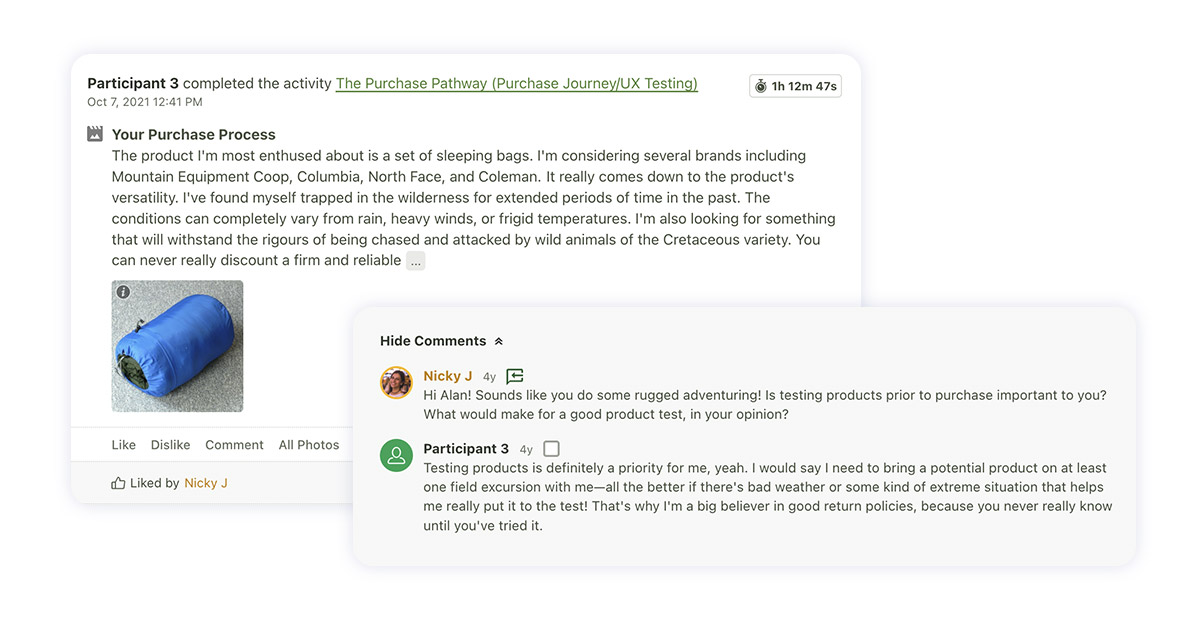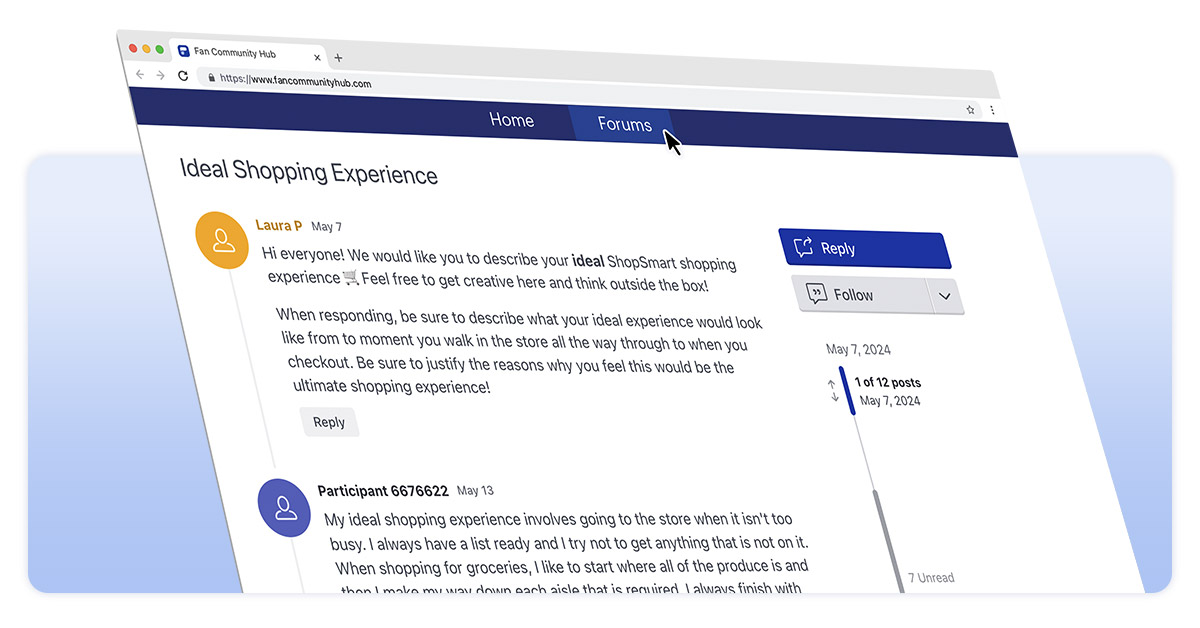Online community-driven research is often misunderstood as an expensive and overly complicated process. In reality, it’s one of the most agile, cost-effective and insightful methods available today. By fostering ongoing relationships with participants in a collaborative environment, researchers can uncover the deeper motivations and emotions behind consumer behaviors—insights that traditional methods simply can’t reach. With the right tools and strategies, the online community research process can be streamlined to fit seamlessly into your existing workflow.
If you’ve ever wondered whether online community-driven research is worth exploring but hesitated due to concerns about complexity or cost, this guide is here to show you that it’s not only achievable but essential for sustainable success.
Whether you’re a market researcher seeking richer data, an in-house insights team looking to optimize processes, or a business striving to stay ahead of customer expectations, this online research communities guide will show you how online community-driven research can become a cornerstone of your success.
Topics We're Covering:
- The Rise of Online Research Communities
- Why Online Research Communities Matter
- Key Components of Successful Online Research Communities
- Leveraging Online Research Communities for Insights
- Best Practices for Online Research Community Management
- Measuring Online Research Community Success
- Integrating Online Communities into the Research Ecosystem
- Future Trends in Online Community-Driven Research
- Next Steps for Optimizing and Implementing Online Research Communities
- Featured Online Research Community Platform: Recollective
The Rise of Online Research Communities
Online research communities have become a cornerstone of modern market research, offering a dynamic and flexible way to engage participants and uncover insights. These communities are far more than just digital spaces, they’re environments where meaningful interactions happen, fostering deeper connections between researchers and participants.
A Brief History of Online Communities
The concept of online communities took root in the early 2000s, driven by advancements in technology like Web 2.0, wireless internet and smartphones. These innovations transformed how people interacted online, shifting from static browsing to active participation. Tools like discussion forums and early social media sites such as MySpace and Facebook introduced users to the idea of sharing thoughts, ideas and experiences in real-time.
As researchers adapted to this shift, they discovered the power of engaging participants in their own digital spaces. Instead of relying on long surveys or expensive in-person focus groups, online communities allowed researchers to “virtually” sit with participants in their living rooms—having richer, more conversational interactions asynchronously. This approach re-energized respondents and researchers who had grown tired of traditional methods and opened the door to more authentic insights.

The Evolution of Online Research Communities
Over time, online research communities evolved into distinct models tailored to different needs. Short-term communities became popular for qualitative research projects like shopper insights or product development, offering a low-cost way to trial the community approach.
Long-term online research communities, on the other hand, provided continuous engagement with participants for ongoing studies or iterative research. Somewhere in between were hybrid models that blended qualitative and quantitative methods in long and short-term communities—offering flexibility without sacrificing depth.
The rise of mobile technology further expanded the possibilities for these communities. Smartphones enabled participants to share high-quality videos and photos, providing researchers with richer observational data. This technological leap also allowed for agile research processes where insights could be gathered quickly and iteratively over time.
Why Online Research Communities Matter
Despite being established more than 20 years ago, online research communities offer unique advantages that make them indispensable tools for modern researchers:
- Continuous Engagement: Unlike one-off studies, communities provide an ongoing dialogue with participants. This allows researchers to follow changes in behavior over time and build a deeper understanding of customers and their preferences.
- Flexibility: Whether you need quick feedback or long-term insights, communities can adapt to your goals. Activities can include quantitative tasks such as polls and surveys through to qualitative exercises such as journals and in-the-moment multimedia uploads.
- Participant Experience: Communities prioritize participant engagement by creating interactive environments where members feel valued. This leads to higher retention rates and more thoughtful responses.
- Cost Efficiency: Communities offer cost savings by leveraging customer or employee lists for recruitment and reducing the need for frequent refreshes. This approach eliminates the expense of recruiting for every project while still delivering high-quality insights tailored to your research needs.
- Depth and Breadth: Communities offer the time, relationships and technology to facilitate researchers to dig deep into motivations, emotions and behaviors.
The Social Element in Online Research Communities
At their core, online research communities thrive on social interaction. Participants engage not just with researchers but with each other—sharing ideas, discussing topics and providing feedback in ways that traditional methods can’t replicate at scale or similar cost efficiency. However, it’s important to note that while social interaction is key, less than 10% of community members typically create content independently. This is why structured activities designed by researchers are so vital—they guide participation while reducing the burden on members.
Insight communities stand out because they strike the perfect balance between structure and freedom. Researchers design activities such as fill-in-the-blanks or open-ended discussions while compensating participants for their time—ensuring engagement without placing undue pressure on members to generate content.
A Case Study in Online Research Community Impact
The power of online research communities becomes especially evident in real-world examples. One early Recollective community was launched during the holiday season—a three-month study designed to explore consumer behaviors among individuals diagnosed with depression during the Christmas period. Unexpectedly, the community evolved into an ongoing self-help group for those participants. Members supported each other through shared experiences while also providing valuable insights for the study. This case highlights how well-managed communities can foster genuine connection alongside high-quality research outcomes.
5 Key Components of Successful Online Research Communities
Creating a thriving online research community is about much more than assembling a group of participants and asking questions. Success comes from building an online community environment where people feel valued, engaged and motivated to contribute while also ensuring the community remains dynamic and relevant over time.
Let’s explore the essential components that make online research communities flourish:
1. Recruitment, Refreshment and Member Management
The foundation of any strong community is recruiting the right people. Start by identifying individuals who genuinely represent your target audience and are open to meaningful engagement. Recruitment isn’t just about filling seats—it’s about setting expectations from the outset. Clear communication about participation, the community’s purpose and how their input will be used helps foster commitment.
But recruitment isn’t a “set it and forget it” process. Over time, even the most engaged communities can experience drop-off or fatigue. That’s why it’s important to plan for periodic “refreshes”—inviting new members or rotating participants to maintain diversity, energy and fresh perspectives. This approach helps reduce bias and keeps the insights flowing.

2. The Role of the Online Research Community Manager
Behind every successful online research community is a skilled community manager. This role is both strategic and empathetic in guiding discussions, troubleshooting issues and ensuring participants feel heard and valued. Online research community managers are responsible for monitoring engagement, welcoming new members and keeping the experience positive and productive.
While research managers focus on study design and analysis, online research community managers are dedicated to enhancing the participant experience and fostering engagement. Together, research managers and community managers form a powerful partnership that ensures both research rigor and a rewarding community atmosphere.
3. Engagement Strategies: Cadence, Variety and Fun
A well-crafted engagement strategy is essential for sustaining interest and avoiding burnout. One proven approach is to establish a regular cadence—typically one to two research activities per week for long-term communities. This keeps members engaged without overwhelming them. Too many activities can lead to fatigue, while too few risk losing momentum.
It’s also helpful to alternate between “research activities” (like surveys, concept tests or diary studies) and “engagement activities” (such as fun polls, games, or casual discussions). Engagement activities are optional and designed to build community spirit, making the experience enjoyable and fostering a sense of belonging.
Mix up the formats: use open-ended discussions, multimedia uploads and gamified tasks to keep things interesting. Remember, only a small percentage of members will create content spontaneously, so structured activities and prompts are key to maintaining meaningful participation.
4. Motivate and Recognize: Incentives, Leaderboards and Badges
Incentivization is about making participants feel appreciated. Offer a thoughtful mix of incentives, from monetary rewards or gift cards to exclusive access or public recognition. Gamification tools like leaderboards, MVP (Most Valuable Participant) shout-outs and digital badges can add a layer of fun and friendly competition, motivating members to stay active and contribute more.

5. Technology and Platform Considerations
The technology behind your online research community matters. Choose a platform that is intuitive for both researchers and participants, offering features such as discussion boards, multimedia capabilities, segmentation and real-time analytics. Mobile accessibility is a must, as many participants prefer to engage on the go. Customization options—such as branded experiences or tailored activity flows—help ensure your community feels welcoming and aligned with your goals.

Successful Online Research Community Case Study: The Cambridge Panel
A standout example of these principles in action is The Cambridge Panel, an online community powered by Recollective. Bringing together teachers from around the world, this community has thrived for over two years by combining thoughtful recruitment, regular refreshes and a balanced cadence of activities. The programming team ensured a mix of engaging research and community-building activities, while skilled community management fostered a welcoming environment where teachers felt heard and appreciated.
The result? The Cambridge Panel has become not just a source of high-impact insights, but also a vibrant space for long-term connection and collaboration among its members.
By focusing on smart recruitment and refresh strategies, skilled community management, a well-balanced engagement plan, meaningful incentives and robust technology, you can create a research community that delivers exceptional insights and a rewarding experience for everyone involved.
Leveraging Online Research Communities for Insights
Online research communities are a powerful way to uncover rich, qualitative insights while overcoming the limitations of scale and cost that often come with traditional methods. They create a space where participants feel comfortable sharing their thoughts, emotions, and real-life experiences, allowing researchers to dive deeply into the “why” behind consumer behaviors. By making in-depth, authentic conversations possible with larger and more diverse groups, communities enable researchers to explore the nuances of human decision-making more efficiently and accessibly than ever before.
Online Research Communities Provide Unique Qualitative Insights
At the heart of every successful online research community is its ability to generate deep, qualitative insights. Through open-ended discussions, storytelling exercises, diary studies or video submissions, participants can share their perspectives in their own way. This allows researchers to capture the context and emotion behind responses—delivering insights that are far more meaningful than numbers alone.
For example, imagine you’re developing a new product concept. With a community, the value goes far beyond simply asking whether participants like the idea. Early in the process, the community could be involved in brainstorming or co-creating concepts with your team, providing real-time feedback on initial ideas. As the concept evolves, you could conduct in-home usage tests (IHUTs) with community members to see how they interact with similar or competing products in their everyday lives. Behavioral research within the community could uncover how the product fits into their routines or solves specific challenges. This ongoing engagement allows for iterative refinement, ensuring that by the time your product is ready to launch, it’s been shaped by authentic insights and resonates deeply with your audience. Community-driven research doesn’t just deliver answers—it creates a collaborative journey that strengthens both your product and your connection to your audience.
Recollective’s platform is designed to make qualitative research easier and more impactful. It provides tools for real-time excerpting, thematic coding and even AI-powered analysis to help researchers identify patterns quickly while maintaining the depth and richness of the data. One researcher noted how Recollective’s AI functionality enhanced their work: “It not only makes my time to insight faster but also gives me the ability to understand my data in a deeper and wider context.”

Online Research Communites Build Connection Through Social Interaction
What sets research communities apart from other methods is their ability to foster genuine social interaction among participants. When people engage with each other through sharing ideas, offering feedback or even debating topics, it creates a dynamic environment where deep research insights emerge organically. These peer-to-peer interactions often reveal perspectives that participants might not have shared in a one-on-one setting.
However, it’s important to guide these interactions thoughtfully. While organic conversations are valuable, structured research activities ensure that discussions remain focused on your research objectives. Insight communities thrive because researchers take an active role in designing activities that spark meaningful dialogue while keeping participants engaged and motivated.

A Case Study: C+R Research and a Global Food Manufacturer
A compelling example of leveraging qualitative insights comes from C+R Research’s work with a global food manufacturer using Recollective’s platform. The goal was to understand how consumers used the company’s products in real-life situations and uncover pain points that could drive innovation.
Over several months, participants shared their experiences through journals and videos, allowing researchers to observe authentic behaviors rather than relying solely on self-reported data. For instance, instead of simply describing their challenges in using certain products, participants demonstrated them in real-time—providing invaluable context that traditional methods often overlook.
This approach not only helped the client develop empathy for their customers’ challenges but also sparked ideas for innovative solutions. By maintaining an ongoing relationship with participants in a user-friendly and engaging environment, the company was able to ask personal and in-depth questions over time—building trust and uncovering richer insights.
The results were transformative:
- The company developed an innovative product pipeline based on solving real consumer pain points.
- They saved significant costs compared to traditional ethnographic studies by eliminating travel expenses and time-intensive observation methods.
- The initiative was so successful that it remains ongoing today as the client continues to tap into consumer feedback for future innovation opportunities.
This case study highlights how qualitative-focused communities can deliver actionable insights while creating meaningful connections between brands and their customers.
Trust as the Foundation for Insight
At the core of every successful community is trust—trust between participants and researchers as well as trust in the process itself. When participants feel respected and valued, they’re more likely to share openly and honestly.
Building trust starts with transparency about how participant input will be used and continues through regular updates on findings or project outcomes. It also involves creating activities that are enjoyable yet purposeful—ensuring participants feel their time is well spent.
Researchers can uncover rich narratives and emotional truths that drive smarter decisions by focusing on qualitative methods within online research communities. As C+R Research’s work with Recollective demonstrates, these communities aren’t just tools for gathering data—they’re spaces for connection, exploration and discovery that deliver insights with real impact.
Best Practices for Online Research Community Management
Managing an online research community is both an art and a science. It requires a thoughtful approach to ensure participants feel engaged, valued and motivated, all while delivering high-quality insights that meet your research objectives. The most successful communities are built on a balance of trust, engagement and a smooth research process—where participants genuinely enjoy being part of something meaningful.
Let’s explore the best practices that can help you create a thriving research community:
Build Strong Relationships with Participants
The foundation of any successful community is the relationship between researchers and participants. People need to feel that their voices matter and that their contributions are genuinely valued. Start by being transparent—clearly communicate the purpose of the community, how their input will be used and what they can expect throughout the process.
Regular communication is essential for building trust. Share updates on how their feedback is influencing decisions or shaping outcomes. Even small gestures, like thanking participants for their time or highlighting particularly insightful contributions, can go a long way in fostering loyalty and engagement.
Find the Right Rhythm: Frequency of Activities
Keeping your community active doesn’t mean overwhelming participants with constant requests. Striking the right balance is key. For most long-term communities, one to two activities per week is often ideal—enough to maintain engagement without causing fatigue. For shorter-term or more intensive projects, you might increase the frequency, but always pay attention to feedback and watch for signs of participant burnout.
Consistency is crucial: regular, predictable activities help build habits and keep your community top of mind.
Keep Activities Fresh and Engaging
A vibrant community thrives on variety. Alternate between structured activities—like surveys, polls and creative tasks—and open discussions that encourage storytelling and peer-to-peer interaction. Activities are great for targeted insights, while discussions foster a sense of belonging and spark organic conversations. This blend keeps engagement high and ensures you’re capturing both depth and breadth in your research.
It’s also important to design activities that are easy to complete and enjoyable. Some participants may love diving into in-depth discussions, while others might prefer quick polls or multimedia tasks like photo or video uploads. By catering to different engagement styles, you ensure everyone feels comfortable contributing.
Motivate with Meaningful Incentives
Incentivization goes beyond just offering rewards—it’s about making participants feel appreciated. While monetary incentives, gift cards or exclusive access can be effective, don’t underestimate the power of recognition. Publicly thanking top contributors, sharing how their input made a difference, or offering small surprises for thoughtful participation can go a long way. Consider a mix of tangible and intangible rewards to appeal to different motivations within your group.

Recognize and Reward: Leaderboards, MVPs and Badges
Gamification elements like leaderboards, MVP (Most Valuable Participant) recognition and badges can inject fun and healthy competition into your community. Leaderboards highlight active members and encourage participation, while badges can be awarded for milestones such as completing a certain number of activities or providing particularly insightful feedback. Spotlighting MVPs in community updates or newsletters not only rewards top contributors but also inspires others to engage more deeply.
Prioritize Participant Experience
A positive participant experience is critical for reducing churn and maintaining high engagement rates. This starts with creating a welcoming environment where members feel safe sharing their thoughts without fear of judgment. Establish clear guidelines for respectful communication and address any issues promptly to maintain a supportive atmosphere.
The Role of the Community Manager
A skilled community manager is the backbone of any successful research community. This role involves much more than moderating discussions—it’s about fostering relationships, guiding activities, troubleshooting issues and ensuring participants have a positive experience throughout their journey.
Community managers need to strike a balance between being approachable and professional. They should actively engage with participants while maintaining focus on the research objectives. This could involve asking follow-up questions during discussions, encouraging quieter members to contribute or even adapting activities based on participant feedback.
It’s worth noting that community managers work closely with research managers but serve distinct purposes. While research managers focus on designing studies and analyzing data, community managers are dedicated to participant engagement—ensuring the community remains active, productive and enjoyable.
Case Study: L&E Research’s Online Community
L&E Research’s work with Recollective offers an excellent example of effective community management in action. Tasked with building an online research community for a client in the healthcare industry, L&E Research needed to create an environment where patients could share their experiences openly while providing actionable insights for the client.
The team prioritized participant experience from day one—designing activities that were easy to complete yet meaningful for members. They used Recollective’s platform features like multimedia uploads to encourage patients to share videos or photos of their daily routines, adding rich context to the data collected.
Community managers played a crucial role in fostering trust among participants by maintaining regular communication and addressing concerns promptly. They also ensured discussions remained respectful and focused on the research objectives while giving members space to share personal stories.
The results were transformative:
- The healthcare client gained deep qualitative insights into patient behaviors and challenges that informed product development strategies.
- Participants reported feeling valued and heard throughout the process—leading to high levels of engagement and minimal churn.
- The success of this initiative demonstrated how thoughtful community management can deliver impactful results while creating a positive experience for everyone involved.
By thoughtfully planning activity frequency, offering meaningful incentives, mixing up formats and celebrating contributions, you’ll create an environment where members want to return, share, and collaborate. Keep experimenting, listen to your community and don’t be afraid to try new approaches—community management is as much about learning and evolving as it is about structure. With these best practices, your community will not only deliver valuable insights but also become a place participants genuinely enjoy being a part of.
Measuring Online Research Community Success
Measuring the success of an online research community is about understanding how well the community fosters engagement, delivers meaningful insights and creates value for both participants and stakeholders.
A successful community is one that not only meets its research objectives but also builds engaging connections with its members. Let’s dive into how to measure success effectively and ensure your community thrives.
Monitor Success Metrics
To ensure your community is thriving, track key performance indicators (KPIs) like engagement rates, activity completion rates, participant retention over time and stakeholder satisfaction with the insights generated. Regularly review these metrics to identify areas for improvement or opportunities to enhance your approach.
Additionally, gather feedback directly from participants about their experience within the community. This can help you refine your strategies further while showing members that their opinions matter not just in research but in shaping how the community operates.
By focusing on strong relationships with participants, engaging activities, skilled leadership from community managers and continuous monitoring of success metrics—as demonstrated by L&E Research—you can create a vibrant online research community that delivers exceptional insights while providing an enriching experience for all involved.
Online Research Community Success Metrics
To truly understand how your research community is performing, it’s important to track a combination of quantitative metrics and qualitative observations. With over 20 years and thousands of communities running on the Recollective platform, we have established benchmarks that can help you set expectations and measure success with confidence.
Engagement is a strong indicator of how invested participants are in your community. On Recollective, average participation rates (the percentage of invited members who actively engage) are:
While shorter communities tend to have higher engagement, well-managed long-term communities can sustain strong rates with the right strategies.
Retention measures how many participants remain active throughout the lifespan of the community. Across Recollective’s online research community platform, acceptance (the percentage of invited participants who join and stay engaged) averages:
Completion rates reflect the percentage of participants who finish assigned tasks or activities. Recollective online research community benchmarks show:
Shorter communities typically see higher completion rates, but thoughtful engagement strategies can keep long-term communities productive.
Insight Quality
While quantitative metrics are essential, the depth, relevance and originality of insights remain the gold standard for success. High-quality communities foster thoughtful, actionable responses that align with your research objectives. Regularly review the richness of discussion, the diversity of perspectives and the practical value of what’s shared.
Impact on Decision-Making
Ultimately, the true value of a research community is measured by how its insights inform business strategies, product development or customer experience improvements. Track how often community findings are referenced in key decisions and gather feedback from stakeholders on the usefulness of the insights provided.
Refreshing Your Community
For long-term communities, periodic “refreshes” are essential for maintaining engagement and diversity. For example, starting with a target of 100 participants, you may need to invite 110 initially, then refresh with 30 new members each subsequent quarter to maintain your desired community size and energy.
By benchmarking your community’s engagement, retention and completion rates against these established Recollective standards—and by focusing on the quality and impact of your insights—you’ll be well equipped to measure, manage and maximize the success of your research community.
Observing Online Research Community Dynamics
While metrics provide valuable data, qualitative observations are equally important for understanding the health of your community. Pay attention to how participants interact with one another—are discussions lively and collaborative? Are members sharing personal stories or unique perspectives? These dynamics can reveal whether your community is fostering genuine connection and trust.

Tools for Tracking Online Research Community Success
Platforms like Recollective make it easy to monitor these metrics through built-in reporting tools and analytics dashboards. Features like segmentation allow you to track engagement across different participant groups, while AI-powered analysis helps identify patterns in qualitative data quickly and efficiently.

Case Study: Horowitz Research and a Print Publisher’s Rebranding
A compelling example of measuring community success comes from Horowitz Research’s work with a traditional print publisher undergoing a full rebranding effort. The publisher needed to understand their new target audience—tech-savvy younger consumers—and gather insights to inform their shift toward digital content and services.
Horowitz Research recommended running a long-term online community using Recollective’s platform to centralize all research efforts in one place. This approach allowed the publisher to engage with participants continuously, adapt their research plan on the fly and respond quickly to ad-hoc requests—all while saving time and money compared to launching multiple standalone studies.
The results were transformative:
- Understanding the “Consumer of the Future”: The community provided an ongoing relationship with younger consumers, offering deep insights into their preferences, behaviors and needs.
- Informed Rebranding Efforts: Insights gathered from the community directly shaped the publisher’s rebranding strategy, including website redesigns and content tailored to a digital-first audience.
- New Consumer-Centric Tools: The publisher developed innovative tools like a credit card comparison feature based on participant feedback—enhancing their value proposition for younger users.
- Flexibility in Research Design: Recollective’s platform allowed the publisher to adjust activities and questions as new insights emerged, ensuring that each phase of research built on previous findings.
- Cost Savings: By keeping all research within one centralized platform, the publisher avoided the expense of running multiple studies while still meeting diverse research needs.
This case study highlights how tracking engagement rates, insight quality and impact on decision-making can demonstrate not only the success of a research community but also its long-term value in driving innovation.
Continuous Improvement
Measuring success isn’t just about evaluating past performance—it’s about identifying opportunities for growth and improvement. Regularly review your metrics alongside participant feedback to refine your approach.
For example:
- If engagement rates are declining, consider introducing new activity formats like multimedia tasks or gamified elements to re-engage members.
- If retention rates are low, reach out to inactive members with personalized messages or incentives to encourage their return.
By staying proactive in monitoring your community’s health, you can ensure it remains a valuable resource for generating insights while providing an enriching experience for participants.
Measuring success in an online research community is about more than numbers—it’s about understanding how well your space fosters connection, engagement and actionable insights. As demonstrated by Horowitz Research’s work with Recollective, when communities are thoughtfully managed and their success carefully tracked, they become powerful tools for driving transformation while building lasting relationships with participants.

Integrating Online Communities into the Research Ecosystem
Online research communities are not standalone tools—they’re an integral part of a broader research ecosystem. When seamlessly integrated, these communities can amplify the impact of other methodologies, enrich data streams and foster collaboration across teams.
By embedding communities into your research framework, you can unlock deeper insights, streamline processes and create a cohesive approach to understanding your audience.

The Role of Communities in the Research Ecosystem
Research communities act as a dynamic hub for qualitative exploration. They provide a space where participants can share their thoughts and experiences over time, offering insights that complement other data sources like surveys or sales metrics. Unlike one-off studies, communities allow researchers to build ongoing relationships with participants—creating a continuous feedback loop that evolves alongside business needs.
When integrated into the larger research ecosystem, communities can:
- Bridge Methodologies: Combine qualitative depth with quantitative breadth by pairing community insights with survey data or analytics.
- Enhance Collaboration: Serve as a centralized platform where stakeholders can engage directly with participants or observe discussions in real-time.
- Support Agile Research: Provide quick access to feedback for iterative testing or rapid decision-making.
- Drive Strategy: Inform long-term strategies by tracking trends and behaviors over time.
Best Practices for Integration
To fully leverage the power of research communities within your ecosystem, consider these best practices:
- Encourage Cross-Departmental Collaboration: Bring together multiple departments—such as product, marketing and customer experience—to shape the research agenda within the community. When teams share access and input, the community becomes a shared resource, spreading costs and maximizing the value of insights across the organization.
- Centralize Data Streams: Use platforms like Recollective to consolidate insights from various sources into one accessible location. This makes it easier to analyze data holistically and identify patterns across methodologies.
- Incorporate Communities Early: Introduce community-driven insights at the start of projects to shape research questions and guide subsequent methodologies. Communities excel at uncovering “unknown unknowns” that can inform more targeted studies later on.
- Encourage Stakeholder Engagement: Invite stakeholders to observe or participate in community activities when appropriate. Seeing participant feedback firsthand can build empathy and drive more informed decision-making.
Case Study: Walnut Unlimited’s Integration Success
Walnut Unlimited provides an excellent example of how integrating research communities into a broader ecosystem can transform processes and outcomes. Since adopting Recollective’s platform in 2020, Walnut Unlimited has engaged over 5,000 participants across 138 distinct projects—ranging from live focus groups to asynchronous studies.
One standout initiative involved gathering insights on families and children by observing real-life behaviors rather than relying on self-reported data. Researchers used Recollective’s multimedia capabilities to collect over 1,150 minutes of video footage across 96 families, capturing authentic moments of toy usage and gameplay.
By integrating Recollective into their workflow, Walnut Unlimited achieved several key benefits:
- Streamlined Processes: Replacing a multi-tool approach with Recollective’s comprehensive platform simplified project management and reduced inefficiencies.
- Enhanced Collaboration: Clients were able to virtually witness the research process firsthand, fostering trust and alignment between stakeholders and researchers.
- Rich Qualitative Insights: Observing behaviors in real-time provided nuanced data that informed product development strategies far more effectively than claimed behaviors alone.
- Business Growth: The ability to offer clients innovative methodologies helped Walnut Unlimited win new business during challenging times like the pandemic.
This case study demonstrates how integrating research communities into an ecosystem doesn’t just improve outcomes—it also creates opportunities for growth by showcasing the value of qualitative insights in driving decisions.
Building a Seamless Online Community Research Ecosystem
To create a truly integrated online research community ecosystem, it’s essential to view your community as a central hub rather than an isolated tool. Use it as a space where qualitative exploration meets broader strategic goals—whether that means informing product innovation, refining marketing campaigns or supporting customer experience initiatives.
Platforms like Recollective make this integration effortless by offering features that connect seamlessly with other tools and methodologies. For example, researchers can pair community discussions with surveys or UX testing apps for a hybrid approach that delivers both depth and scale.
Integrating online research communities into your broader ecosystem is about creating synergy between methodologies, teams and insights. As Walnut Unlimited’s experience shows, when communities are thoughtfully embedded into workflows, they become powerful drivers of innovation—helping businesses uncover deeper truths while streamlining processes and fostering collaboration across stakeholders.
Future Trends in Online Community-Driven Research
The world of online community-driven research is evolving at an incredible pace, reshaped by advancements in technology, shifts in participant expectations and the growing need for agile, meaningful insights. As we look to the future, it’s clear that insight communities are becoming more than just tools for data collection—they’re transforming into dynamic “intelligence hubs” that centralize knowledge and foster deeper connections between researchers, participants and brands. These emerging trends are paving the way for a more connected, efficient and impactful approach to qualitative research.
Whether you’re exploring short-term projects or building long-term panels, online research communities offer unmatched flexibility, depth and engagement—making them an essential tool for any researcher looking to stay ahead in today’s fast-changing landscape.
AI: Redefining the Research Process
Artificial intelligence is revolutionizing how researchers approach data synthesis and analysis. AI tools aren’t just speeding up processes—they’re fundamentally changing how researchers think about their work. During a recent webinar hosted by Recollective, Lenny Murphy of GreenBook highlighted how AI is freeing researchers from time-consuming tasks like thematic coding and manual analysis. “The ability to automate grunt work frees researchers to be more strategic,” he explained.
Recollective’s AI-powered features are at the forefront of this transformation. Researchers can now analyze data in real-time while studies are still in progress—asking questions, comparing groups and diving deeper into emerging themes as they arise.
Laura Pulito of Recollective emphasized how this capability allows researchers to adapt on the fly: “You don’t have to wait until you’re out of field to start your analysis. You can explore themes and make adjustments instantly.” This agility not only saves time but also ensures that insights remain relevant and actionable throughout the research process.

Mobile-First Communities: Meeting Participants Where They Are
As mobile devices continue to dominate how people interact with technology, research communities are embracing mobile-first designs to meet participants where they are. Mobile-friendly platforms allow participants to engage seamlessly—whether they’re sharing a quick thought during their commute or uploading a video from their living room. This accessibility reduces barriers to participation and encourages ongoing engagement, ensuring that communities remain active and vibrant over time.
Mobile-first design also enables conversational approaches to research. Instead of rigid tasks or surveys, participants can engage in natural, intuitive interactions that feel more like conversations than formal studies. This approach builds trust while capturing richer, more authentic insights that reflect real-life experiences.
The Rise of Intelligence Hubs
Insight communities are increasingly evolving into intelligence hubs—centralized platforms that integrate data from multiple sources and provide instant access to actionable insights. These hubs enable organizations to streamline their research processes, making it easier to draw connections across different methodologies and uncover deeper truths about their audiences.
Lenny Murphy described this shift as moving toward a world where “conversation becomes the new form factor for research,” powered by advancements in AI-driven analysis. By blending qualitative depth with conversational data collection, intelligence hubs offer a holistic view of consumer behavior that drives smarter decision-making.

Democratizing Online Research Community Tools
Another exciting trend is the democratization of research tools. Platforms like Recollective are making qualitative research more accessible to users beyond traditional research teams—allowing marketers, product developers and other professionals to tap into community insights directly.
Laura Pulito noted how this shift is empowering companies to bring more voices into the insights process: “By simplifying tools and workflows, we’re opening up qualitative research to people without formal research backgrounds.”
This democratization not only broadens who can participate in research but also fosters collaboration across teams—ensuring that insights inform decisions at every level of an organization.
As insight communities evolve into intelligence hubs powered by AI and mobile-first technology, they’re becoming indispensable tools for modern researchers. By embracing these future trends—like conversational design, hybrid methodologies and democratized access—researchers can unlock richer insights while fostering stronger connections with participants. Platforms like Recollective are leading this transformation by equipping organizations with the tools they need to create communities that aren’t just spaces for data collection but dynamic ecosystems for innovation.
Conclusion
Community-driven research offers a fresh, transformative way to connect with your audience and uncover insights that truly matter. It’s not just about gathering data—it’s about creating spaces where participants feel heard, valued and empowered to share their authentic thoughts and experiences. These communities unlock deeper layers of understanding, helping you grasp the motivations, emotions and context behind consumer behavior.
In a world where customer needs are constantly evolving, insight communities provide the agility and depth necessary to keep pace. They allow you to stay in tune with your audience, adapt quickly to changes and make informed decisions that drive meaningful impact. Whether you’re brainstorming new product ideas, refining strategies or tracking trends over time, community-driven research ensures you stay one step ahead.
Next Steps for Implementing and Optimizing Online Research Communities
If you’re ready to harness the power of community-driven research, here’s how you can get started:
Define Your Goals: What do you want to achieve with your research community? Whether it’s exploring customer needs, testing new concepts or tracking brand perception over time, having clear objectives will guide your strategy.
Choose the Right Partner: Building a successful community isn’t just about selecting technology—it’s about finding a partner who understands your goals and supports you every step of the way. Look for a platform like Recollective that not only offers robust features and real-time analysis, but also provides expert guidance and support to help you achieve lasting success.
Recruit Thoughtfully: Focus on finding participants who represent your target audience and are motivated to engage meaningfully with your activities.
- Design Engaging Activities: Keep participants interested by offering a mix of tasks that are easy to complete yet meaningful for your research objectives.
- Leverage AI for Deeper Insights: Use AI-powered tools to analyze responses quickly and identify patterns that might otherwise go unnoticed.
- Iterate and Improve: Regularly review your community’s performance metrics and participant feedback to refine your approach over time.
If you already have a research community in place but feel it could be delivering more value, now is the perfect time to optimize it with Recollective’s Guided Discovery Platform. From enhancing participant engagement to streamlining data analysis, Recollective can help you unlock the full potential of your community.
The Time to Act Is Now
The future of market research is here—and it’s powered by communities that bring together people, technology and insights in ways we’ve never seen before. By adopting a community-driven approach with Recollective’s Guided Discovery Platform, you can transform how you understand your audience and make decisions that move your business forward.
Don’t wait for tomorrow to start innovating today. Take the first step toward building or optimizing your research community—and discover how Recollective can help you turn customer insights into action! Reach out to learn more about how our platform can empower your team and revolutionize your approach to qualitative research.
The possibilities are endless—let’s explore them together!
Featured Online Research Community Platform: Recollective
Community-driven research is transforming how organizations gather insights, make decisions and connect with their audiences. At the forefront of this evolution is Recollective—a Guided Discovery Platform shaped by decades of experience and an unwavering commitment to impactful communities.
Founded in 1998 as Ramius Corporation, Recollective’s heritage is rooted in pioneering online collaboration and research technology. As market needs evolved, Ramius launched the Recollective platform in 2011, specifically tailored to empower market researchers with deeper qualitative insights and flexible community-driven approaches. In 2019, the company unified under the Recollective name, reflecting its focus on delivering best-in-class qualitative research and insight community technology.
Today, Recollective is trusted by leading brands and agencies—including Hall & Partners, Kantar, Facebook, Netflix, Google, and Uber—for its ability to deliver rapid, actionable insights at scale. The platform is recognized as a global benchmark for intuitive design, segmentation capabilities and flexible research workflows.

The Transformative Power of Recollective
Recollective’s Guided Discovery platform takes community-driven research to the next level. It brings together the best of insight communities, versatile qualitative research tools and cutting-edge AI technology—all seamlessly integrated to deliver actionable customer insights.
With Recollective, you can:
- Engage Participants in Meaningful Ways: Create dynamic activities that spark authentic conversations and uncover deeper truths about your audience.
- Adapt on the Fly: Use AI-powered tools to analyze data in real-time, allowing you to pivot your research as new themes emerge.
- Centralize Your Research Efforts: Consolidate your insights into one intuitive platform that supports collaboration across teams and methodologies.
- Deliver Impactful Results: Turn raw data into actionable insights that drive innovation and inform strategic decisions.
Recollective doesn’t just make online market research easier, it makes it smarter. By simplifying workflows and empowering researchers with advanced tools, it allows you to focus on what really matters: understanding your audience and delivering value to your organization.
From its origins in online collaboration to its role as the industry’s trusted Guided Discovery Platform, Recollective helps organizations unlock the full potential of their communities and redefine what’s possible in research.
Let us show you how we can support your next research project or community. Book your demo today.






.svg)
